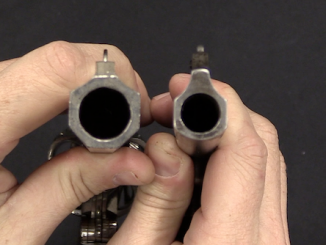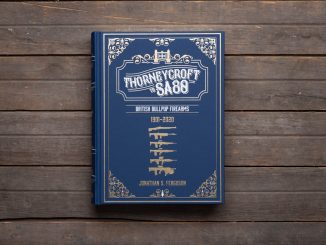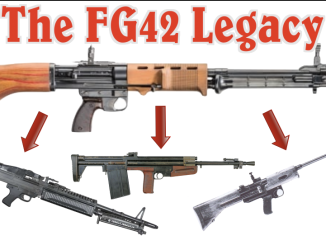Development of the .50 caliber Vickers guns began during World War One, but stagnated after 1918, and was not really completed until the early 1930s. At that point, Vickers produced a series of the guns for use primarily as armored vehicle armament and for antiaircraft use. It was formally adopted in 1933, and declared obsolete in 1944. A total of 1,117 were made for ground use, plus more for naval use. The ground guns ran from MkI to MkV, with today’s example being a MkIV.
Related Articles

Revolver
.577 Caliber Bland-Pryse Stopping Revolver
This revolver is lot #2573 at Morphy’s April 2019 auction. There were probably less than a hundred of these Pryde-Patent break-action .577 revolvers made in total, and this one has managed to maintain an excellent […]

Book review
Sneak Peek at Thorneycroft to SA80 with the Author, Jonathan Ferguson
Jonathan Ferguson, author of our newest Headstamp Publishing book “Thorneycroft to SA80: British Bullpup Firearms 1901-2020”, has just gotten his advance author’s copy of the book! Let’s join him to take a look through its […]

Commentary
The Post-War Legacy of the FG42
If the FG-42 was such a great gun, then why didn’t it get used after the war? Well, two answers… 1) It was crazy expensive to make and there weren’t very many lying around for […]

“Water-cooled guns had become obsolete” – for infantry mobility purposes.
They would make a lot more sense (even today) than borrowing an infantry gun that trades sustained-fire reliability and accuracy for (completely irrelevant and pointless on a vehicle) lightness and portability. All the more so on ships.
Water cooling turned out to be a major headache in the light tanks which were the major users of these. In an infantry application you simply put the condenser can wherever is convenient. You can’t do that in a light tank, there simply isn’t the room and you don’t want steam filling the turret anyway.
The solution adopted was to hook the water jacket into the vehicle radiator system and cool it that way. That was an unsatisfactory solution though, as you had hot water hoses in the tight confines of the interior of the vehicle and you had the problem that the turret had to be able to rotate while somehow connecting these hoses back to the engine compartment.
Fairly early in the war these guns were replaced by the 15mm Besa in both light tanks and in armoured cars, the latter of which stayed in front line service through the war. The 15mm Besa was air cooled and a much more modern gun overall. In terms of performance it was very close to the later Soviet 14.5mm machine guns.
An air cooled version of the Vickers .50 would have made more sense for vehicle use. The aircraft version was air cooled so there probably weren’t any technical reasons why this wouldn’t have been possible. It’s quite possible though that with the 15mm Besa in the works there was no reason from the user perspective to develop an air cooled version when the Besa was going to be the future anyway.
To me the purpose of a water-cooled MG is the ability to fire off thousands of rounds at a single event. When did anyone ever use a secondary tank MG for that? For a tank, it would be more like hundreds of rounds at most. Cheaper to just build a heavy-barrel air-cooled gun.
The Vickers .50 cal was used as primary, not secondary armament on the British light tanks and the infantry tank Mk I a.k.a. Matilda I (early ones were armed with the .303 Vickers). The job of those tanks was to support infantry attacks, which meant that their main weapon would be used quite a lot for suppressing enemy strongpoints, such as machine gun nests. In light of that water cooling did make some sense in my opinion.
In practice, of course, the .50 cal was too light for main weapon of even light tanks, since it had very limited anti-tank capability. Its replacement, the 15mm Besa, turned out to be reasonably effective against Italian tankettes and armored cars.
Aircraft Vickers could be air cooled because aircraft provided a continuous volume of high-velocity cooling air. Tanks not only offer nothing of the sort, but also generally isolate the most heat-vulnerable section of the barrel from any air circulation at all.
Maxim developed the water-cooled MG due to water’s superior specific heat capacity, noting that it takes as much energy to boil a gallon of water (the capacity of a Maxim jacket) as it does to melt five pounds of iron – the approximate weight of two Maxim or Vickers barrels, which didn’t need to be thick or heavy. Thermal-expansion-induced stoppages or ruining the temper of a barrel require far less heat than melting it. Thus, by the time a condenser would become absolutely necessary, an air cooled MG would have needed what, 5-10 barrel changes? Except, of course, that fixed (coax or bow) mountings wouldn’t allow barrel changes for most MG designs. Also, with ~7.5 gallons per cubic foot, simply carrying that much spare water would have allowed many times more firing than any air cooled MG.
I have read the same things you have posted about unsatisfactory condenser arrangements, and can only surmise that it was due to using MGs in the WWI sense, with the tanks acting as rolling bunkers. Air-cooled guns would not have been inconvenient, but simply unable to perform in that role.
“(…)can only surmise that it was due to using MGs in the WWI sense, with the tanks acting as rolling bunkers. Air-cooled guns would not have been inconvenient, but simply unable to perform in that role.”
Err… but during Great War-era female British tanks evolved from mix to solely air-cooled machine guns armament.
Mark I Female 4 x Vickers + 1 x Hotchkiss
https://tanks-encyclopedia.com/ww1/gb/tank_mki.php
Mark IV Female 6 x Lewis
Mark V Female 6 x Hotchkiss
Mark V star Female 6 x Hotchkiss
CHARACTERISTICS OF BRITISH TANKS USED DURING THE GREAT WAR from
Tanks in the Great War, 1914-1918 by J. F. C. Fuller
available at Project Gutenberg
Desperate wartime conditions – possibly cost? Manufacturing time?
@Mike
Air cooled machine guns were also less vulnerable to enemy fire, which the tanks would certainly draw even more than individual machine guns on ground mounts. Furthermore, it was probably easier and cheaper to manufacture tanks without the armored sleeves for machine guns that the WW2 British tanks with the water cooled Vickers guns sported.
I don’t imagine an armored sleeve or two would contribute significantly to the (huge) overall price of a tank, but I could be wrong.
You and some others make fair points in favor of a robust air-cooled MG, but there is still no reason to mount models that trade away sustained fire for portability – particularly back in the days when there was a difference.
My much loved grandfather was a gunner on the water cooled .30 browning in the horse cavalry. Lots of great stories about kicking mules and the dangers of Mexican jails. I’m curious. How does one clean the water jacket on these weapons? Were they issued distilled water for the guns?
Cooling water was essentially the same water they put in the radiators of the vehicles. In cold weather, it was mixed with antifreeze for the same reason they did that in radiators.
Cleaning was also as per vehicle radiators. One often-used shortcut was to mix vinegar about 50/50 with the water and fire two or three belts through the gun. The boiling water/vinegar combination would clean out “scale” in the jacket just like it does in your coffeepot.
cheers
eon
That reminds me, I’ve got to clean out my coffee brewer. And yes, I do recall that scale buildup can actually cause some nasty damage to boilers if not checked (eventually resulting in a boiler explosion that would easily kill a locomotive crew). No, I’m not suggesting that any steam engine near me is suffering from boiler-ache.
Thank you eon. A very knowledgeable man.
If you are interested in care of water-cooled machine guns you might find interesting
HANDBOOK OF THE MAXIM AUTOMATIC MACHINE GUN CALIBER .30, MODEL OF 1904 WITH PACK OUTFITS AND ACCESSORIES
{SEVENTEEN PLATES)
JUNE 15, 1906
REVISED JANUARY 7, 1908
REVISED APRIL 26, 1913
REVISED AUGUST 21, 1915
REVISED JULY 5, 1916
War Department, Office of the Chief of Ordnance,
Washington, July 5, 1916.
This manual is published for the information and government of the Regular Army and National Guard of the United States. By order of the Secretary of War.
William Crozier,
Brigadier General, Chief of Ordnance.
available at
https://www.allworldwars.com/Handbook%20of%20the%20Maxim%20Automatic%20Machine%20Gun%20Model%201904.html
Thank you! Very useful, especially as regards harnessing the mules!
cheers
eon
CORRECT DESIGNATION:
VICKERS CAL. .5 inch MG
( not “50cal”)
Also supplied for Export as a Semi- Rimmed case, which became the Breda 12,7x81SR, and the Japanese Ho103, a BMG-clone Gun, with same cartridge.( used both Italian AND Japanese made Ammo in WWII.)
As well as North Africa, the Vickers .5 was used in the British invasion of Iraq,1941 to put down a pro- Nazi coup there.
Guns mounted on Vehicles.
Other than the misnaming,
A good video. Saved to my Hard drive file.
Doc AV
Before anyone gets on the British for using a .5 inch machine gun and a coax 303 on their light tanks, let me point out that the contemporarry US M1 and M2 series light tanks (with the exception of the M2A4) mounted 50 and 30 caliber Brownings, the German Panzer I had two 7.92mm MG’s, the Russian T37 and T38 had one 7.62mm gun and the T40 had a 12.7mm and coax 7.62mm. The Infantry Tank Mk I (Matilda I) was an aberation as Vicker’s Sir John Carden had to design it to a very low price in the depths of the depression.
https://en.wikipedia.org/wiki/Light_tanks_of_the_United_Kingdom
https://en.wikipedia.org/wiki/Matilda_I_(tank)
No one seems to have mentioned the naval use of the gun. It was mounted in quad mounts as the light AA armament of Britsh destroyers, cruisers and capital units (replaced by the 20mm Oerlikon) and in dual mounts aboard Mtotor Torpedo Boats and Motor Gunboats and other small units. Single mounts were also available
https://gearsofguns.com/gun-of-the-day-vickers-5-inch-heavy-machine-guns/
^The twin Mark IV mounting was used mainly on MLs, MMS, some Bangor class minesweepers, and trawlers.
^The Mark V twin turret was a light weight unit intended for MTBs but was also used on a few LCS(M), destroyers and corvettes. It was hydraulically powered and the belt feed ran through hollow inner trunnions. The hydraulic pump was located off the mounting and this was powered from the engine of the MTB.
https://www.pinterest.com/pin/787004103606684990/
^Large ships usually had four quad mountings, but HMS Ark Royal had eight. Cruisers had two to four and destroyers had two.
http://navweaps.com/Weapons/WNBR_5-62_mk3.php
https://www.quarryhs.co.uk/Vickers.html does mention following foreign users of Vickers .5 inch, designated the Mark III
(…)
China bought 19 examples of this gun.
(…)
A specification document dated November 1935 exists concerning the supply of “Vickers 12.7 mm Automatic Gun Mark III (Amended)” for installation in submarines of the Turkish Navy; it is now known that the guns were delivered and used.
(…)
I played with British boats and ships on War Thunder. The large-caliber Vickers guns do manage to sink enemy torpedo boats rather quickly at close ranges, assuming you catch them by surprise first in coastal waters.
“(…)let me point out that the contemporarry US M1 and M2 series light tanks (with the exception of the M2A4) mounted 50 and 30 caliber Brownings, the German Panzer I had two 7.92mm MG’s, the Russian T37 and T38 had one 7.62mm gun and the T40 had a 12.7mm and coax 7.62mm.(…)”
In 1930s machine guns-only tank were nothing uncommon, but British use of water-cooled as main armament stands out.
All mentioned have all carried air-cooled machine guns. As did Imperial-Japanese Type 94 tankette, Royal-Italian FIAT 3000 (machine gun version), Swedish Strv m/37
You have to tremember, the British only look stupid.
1) They put armored sleaves around the water cooled guns to protect them 2) The Thirties was not a period when large R&D budgets were available and given the understandable “Buy British” attitude during the Depression buying another country’s product wasn’t in the cards. They didn’t adopt the Besa until war was staring them in the face – which is why it remained in 7.92mm, they’d run out of time. If it had been normal times economically, almost assuredly they would have paid for the development of a British gun starting around 1930 or so and never gone with the Czech gun (since the RAF had adopted the Browning in 303, why the Army didn’t adopt it as a coax is one of life’s little mysteries) 3) The Vickers beat the Browning 50 caliber in the British trials
https://www.quarryhs.co.uk/Vickers.html
“They didn’t adopt the Besa until war was staring them in the face – which is why it remained in 7.92mm…”(C)
They were not up to it.
They had to spend all the money on the construction of the largest and (as it turned out) the most useless ships.
This has happened and is happening and will certainly happen when the question of “what kind of trash to invest in” is decided by the friends and companions of the producers of this trash.
The funny thing about the Matilda I was that the German actually had their own version of the concept, namely a heavily armored but fairly inexpensive light tank intended exclusively for infantry support. The resulting vehicle was the Panzer I Ausf. F, which had enough frontal armor to be immune to the Soviet 45mm anti-tank guns, much like the Matilda I had been to the German 37mm guns.
It has sometimes been claimed that the Panzer I F was even inspired by the Matilda I, since it was manufactured in 1942(!), that is well after the Battle of France, but actually the initial order for the vehicle was placed already in 1939. Perhaps the (limited) success of the Matilda I may have encouraged the Germans to go through with the manufacturing of the rather anachronistic vehicle by 1942, however. This is just my speculation, I have no evidence for it. Nevertheless, the Panzer I F seems to have been reasonably successful especially in the anti-guerrilla operations in the Balkans. In any case it was probably one of the last tanks designed with machine gun only armament. (There are of course a plethora of later light armored vehicles with machine guns only, but they do not fit the traditional definition of a tank.)
“(…)Panzer I Ausf. F(…)”
There also existed VK 16.01 https://tanks-encyclopedia.com/ww2/germany/panzer-ii-ausf-j which was also heavily armoured and relatively (to its’ overall weight, 18 tons*) weakly armed – with 2 cm KwK 38 and MG 34.
*metric
This article on my website puts the gun into context: https://www.quarryhs.co.uk/Vickers.html
How many madmen, excuse me, big bore enthusiasts have made rifles chambered for .5 inch Vickers?
Probably None. Even if supplies of Cartridges did show up during the Libyan
Revolution several years ago (mostly Breda 12,7x81SR),the Rimless British .5 inch version is Collectible ammo only.
And there is no case from which it can be made.
.50 BMG is much too large to
Resize suitably ( head and body diameters)…I know, I have a 12,7x81SR Japanese BMG…and some original ( coral encrusted) cartridges for it ( Japanese and Breda)
So a Bolt gun would be a Pipe-Dream in Chinese sense of the term.(Papaver officinum)
If you need .50 caliber but lighter than .50 BMG and more readily available than Vickers cartridge consider RN-50 which consume ammunition of M8C spotting rifle https://www.thefirearmblog.com/blog/2017/05/10/mark-serbu-shoots-rn-50-rifle-chambered-50-spotter-tracer/
“(…)rifles chambered for .5 inch Vickers(…)”
Said cartridge actually evolved from 600 Nitro Express cartridge, see 1st photo from top
https://sites.google.com/site/britmilammo/-5-inch-vickers
Predecessor of this cartridge was used in Godsal 1918 Anti-Tank Rifle
https://www.historicalfirearms.info/post/183659980049/godsal-1918-anti-tank-rifle-while-the-imperial
The Australian War Memorial has a Vickers .50 cal which came from New Zealand and was used by the merchant marine during WWII.